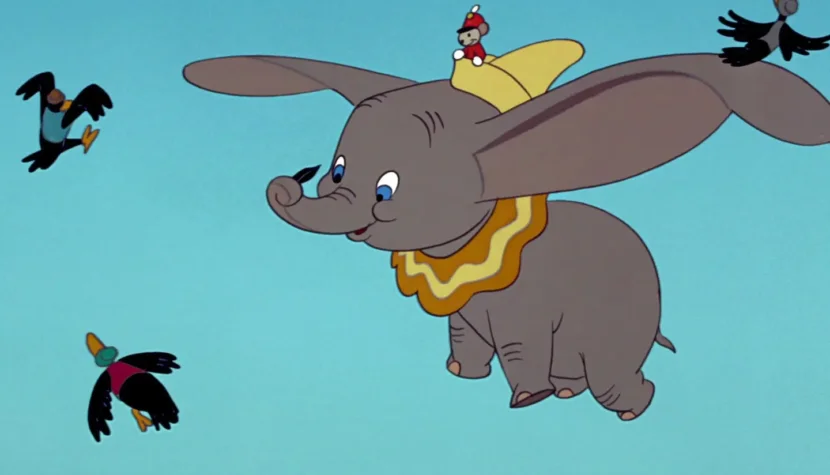DUMBO. Essential viewing

“Dumbo” is Walt Disney‘s third feature-length animated film. It still raises ideological concerns but is justifiably considered one of the studio’s best. The movie begins with a song about storks delivering young animals to their future parents. Everything would be fine if not for the stark contrast between the blissful, cheerful melody and the awkward, perhaps daring lyrics. The lyrics include lines like: “You may be poor or rich. It doesn’t matter which. Millionaires, they get theirs like the butcher and the baker. So look out for Mr. Stork and let me tell you, friend. Don’t try to get away. He’ll find you in the end.” It’s a bitter twist, a bitter film.
This tone is more akin to a dark prophecy. In it, the baby becomes a symbol of unavoidable punishment that could strike at any moment. A child is not a blessing here but a threat capable of shaking one’s mental peace. Don’t try to run from the stork; it will find you in the end. This is the first significant discord in “Dumbo”’s undoubtedly intriguing narrative, an animation that fascinates less with its uplifting moral than with its questioning of how the world operates. It also concentrates on numerous social issues, such as various forms of enslavement, ostracism, physical disability, and exploitation. Not all of these themes receive the expected interpretation and judgment. To add to this, the creators don’t shy away from using biting humor, which sharpens the film’s ideological undertone even more. Nevertheless, “Dumbo” is essential viewing.

The titular character is an awkward young elephant with disproportionately large ears. They cause him physical difficulties because he cannot control them and constantly trips over them. They’re also a source of insecurity and painful isolation. The circus elephants he grows up around criticize his unusual feature, while audiences mock him, calling him an outcast. His mental distress intensifies when he is separated from his mother, his only caretaker. But then Timothy, a mouse touched by Dumbo’s plight, appears. He sees that the elephant’s big ears are actually an asset and should be used for flying. The protagonist only succeeds when he defies his burdensome DNA.
“Dumbo” lingers in memory not for its uplifting moral, but for several sequences and images. They show just how unexpectedly (and not always positively) legendary Walt Disney viewed the world. This 1941 animation is a highly transparent allegory of reality, a utopia about a social order that was never sustainable. It’s particularly striking to see the happily “enslaved” animals in the circus: proudly crammed into train cars, uncomplaining of their exploitative owners, and even helping set up the circus tent in a downpour without protest. A particularly unsettling moment comes when a caged monkey, to the rhythm of lively music, begins shaking the bars. When it manages to pull one out, it doesn’t think of escape but instead cheerfully puts the bar back in place. Everyone must know their place in line, and the subtext of this scene is strikingly clear.
Walt Disney is as controversial as he is compelling. His film bursts with creative energy, though not always appropriately restrained.
One of the circus performances by clowns dressed as firefighters also raises questions. In a deliberately clumsy attempt, they try to extinguish a burning building in which Dumbo, resembling a baby, is trapped. This immediately begs the question: what’s fair game for humor, and what isn’t? Is such a tragic situation an appropriate starting point for a comedic sketch? Of course, the scene is also meant to highlight Dumbo’s helplessness, but it seems that the balance between drama and comedy is poorly managed, with the emphasis placed primarily on humor. Yes, this animation was created with a young audience in mind.

Disney’s “Dumbo” made cinematic history not only for its titular character but mainly for the remarkable, hypnotic dream sequence triggered when Dumbo accidentally drinks champagne. Against a black background, vibrant outlines of elephants appear, skating, playing instruments, or dancing sensually. The initially cheerful mood gradually morphs into a nightmare aesthetic, with the figures demanding the dreamer’s attention. In this sequence, we delve into Dumbo’s psyche, confronting his desires, fears, and self-perceptions, all amplified by the effects of alcohol, which distorts and intensifies his vision. This dream is undoubtedly one of the studio’s peak achievements.
“Dumbo” has its highs and lows. It engages with an intricate emotional layer, exemplified by the touching relationship between Dumbo and his captive mother. The animation conveys the weight of Dumbo’s predicament. The little elephant is genuinely besieged and helpless. When he finally breaks free from his insecurities and proves his worth, there’s a sense of relief. The viewer forms a bond with the character.
However, there’s an underlying sense of unease and oddity to this film, one that might even provoke outrage. “Dumbo” is intellectually stimulating but outdated in its themes. It’s timeless and yet no longer relevant. Regardless of one’s final judgment, this film is worth experiencing as a test of one’s sensitivities.

